So as we approach
that hectic period when Brandon was created, we see that conventional
thinking in 1879 wouldn't have predicted that in less than two years
the new town would appear overnight, and within days this unanticipated
collection of hastily erected commercial buildings would become the
most important place on the prairies west of Winnipeg.
The summer of
1880 saw quite an upswing in activity in the neighbourhood of the
future city of Brandon and the Winnipeg newspapers did take an
increasing interest in the happenings in our area. For instance on
April 16, 1880 the Winnipeg Times reported that; "A ferry has been
established at the Grand Valley crossing of the Assiniboine River. This
will give people visiting the Souris country from the north shore
better travelling facilities. Another ferry is projected at Brandon
crossing 15 miles further down the river." (5) 16-April, 1880 -
Winnipeg Times
The article seems
to indicate that the importance of the Grand Valley location was that
it offered access to the regions to the south were settlements near the
mouth of the Souris, and in the Turtle Mountain area, were just
beginning. That is not to say Grand Valley wasn't a destination in and
of itself. The McVicars, who first appeared in 1878, had established a
river crossing, a steamboat landing and eventually some warehouse
buildings to facilitate its role as a river port. But that was about
it. The article also reminds us that although the name Brandon appears,
its use bears no relationship to the site of the current city. The
projected "Brandon crossing" ferry sight would in fact close to the
location of the former fur trade posts at Souris and near the already
established town of Millford. If the term was used in reference to a
community, that community would be the Brandon Hills settlement.
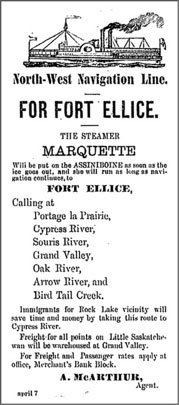 Stops
on the
steamboat route didn’t include Brandon.
Stops
on the
steamboat route didn’t include Brandon.
7-May,
1880 -
Winnipeg Times
The above ad
reminds us that in the pre-settlement days place names had flexible
meanings. A place didn't need to be a "town", in the sense that we know
it, to be on the map. Indeed in the sparsely settled land that we now
call home, towns and villages were of little consequence. There weren't
enough farms, therefore, enough commerce, to justify them. Portage la
Prairie was a town, indeed an important one. Cypress River, Souris
River, Oak River, Arrow River and Birdtail Creek were not towns but
landings named after streams entering the Assiniboine. (Cypress River,
Oak River and Arrow River would later come to identify towns, but in
each case many kilometres from the river landings.) In the case of
Grand Valley, although it later aspired to being a town, it was, as we
see, essentially a landing - a stop on a route.
Another
informative story, from The Winnipeg Times in May 17, tells us of a
party of sixty immigrants brought to Rapid City as part of an organized
colonization program. It reminds us the Rapid City was expected to be
the commercial centre of the region.
On January 6,
1881, The Winnipeg Times reprinted a Letter to the Editor from the
Montreal Witness about, "an educational institution recently
established in Rapid City." The letter outlines the reason for the
establishment of said institution: "allow young settlers (men) to
receive a good mental training" and to be "brought under the influence
of the gospel." The letter is notable for two reasons. Once again
we witness the pre-eminence of Rapid City as the place to be in western
Manitoba (technically still the Northwest Territories). As well, we are
witnessing the beginnings of the McKee Academy, which later moved to
Brandon, setting up shop on the upper level of the Fraser Block before
being incorporated into the Brandon College. All in all it tells us
quite a bit about Brandon's roots.
So in the winter
and early spring of 1881 we see only hints of the changes that were
taking place in terms of settlements, post offices and routes.
Hindsight allows us to see the occurrences in these few months as what
we might now term a paradigm shift in settlement patterns; all hinging
on the C.P.R. decision to follow a much more southerly route to the
Rockies, which would soon be followed by the choice of the exact
location of the necessary Assiniboine crossing.
By the end of
March 1881, something was in the air. Discussion was taking place, and
decisions would soon be made that would alter the future of settlement
and commerce in western Manitoba.
The month of
April, 1881, which was to become, in hindsight, such an important month
for the future city of Brandon, was quiet in the media. But the
news that did appear turned out to be quite important.
The Toronto Daily
Mail, (April 5, 1881) under the heading, "Manitoba Notes", datelined
April 5, has picked up the story that "General Rosser, chief engineer
of the Canadian Pacific railway, has returned from locating the second
hundred miles west, and has instructed the district engineer to direct
the main line some distance east of the terminus a hundred miles, so as
to run south-westerly toward the Assiniboine, and cross near the rapids
of that river."
The rapids are a
few kilometres downstream from today's Brandon. If you drive east on
Richmond Avenue as far you can, walk down to the riverbank and look
south, you will be looking at the very beginnings of those rapids. It
is clear from this article that the exact site of the future crossing
has not been chosen, but that article and the rumours that would
certainly have accompanied it, would have caught the interest of
settlers, or anyone with an interest in speculating in the region.
This would
confirm the worst fears of settlers along the Carleton Trail. The
railway that they felt was coming their way would bypass them. Their
loss would mean an opportunity for settlers and landowners along the
newly announced southern route.
Buried in the
third paragraph of an article in the Toronto Daily Mail (April 18)
(reprinted from the Winnipeg Times but based on "Cable news from
England") we learn that at a meeting of the shareholders of the
Canadian Pacific railway has announced that, "350 miles of railway west
of Winnipeg are expected to be in operation by the end of the present
year." and it later refers to "the crossing of the Assiniboine at Grand
Valley". We also learn that "General Rosser has just returned from a
reconnaissance of the proposed route for some distance west."
There was no
doubt that the immediate vicinity of our hometown was about to become a
more important place, but details remained sketchy, and the exact
location of the crossing was either not yet decided, or kept secret.
As recently as
February 11 of 1880 an ad by the CPR in the Winnipeg Times sought
tenders for the construction of a rail line line from, "near the
western boundary of Manitoba (at that time this was near Gladstone) to
a point on the west side of the valley of Bird Tail Creek.” It seemed a
done deal.
The announcement
that a rail line, in fact the main rail line, was now coming this way,
was a surprise. Some would say that was the whole point. The C.P.R. and
its operatives, General Rosser in particular it seems, stood to make
more money by opening up new towns rather than visiting established
ones. Whatever the motivation, the railway was coming and excitement
would follow.
May, 1881
One finds, from
early May, increased confirmation the railway would cross the
Assiniboine near Grand Valley.
How was the
decision made to locate the station, and thus the town site where
Brandon sits today? Why was it not located on the site of Grand Valley,
an established steamboat landing and ferry crossing with a post office,
store and a few other facilities? There are two theories. One is that
physical aspect of Grand Valley was not suitable. The river was
high that spring and the Brandon site offered a more secure location.
The other story is that Dougald McVicar, the owner of the Grand Valley
site held out for a higher price and Rosser, who intended to make a
profit himself on the creation of town sites, found a better deal
upstream.
The Grand
Valley
Incident
When rumours
began to circulate that the transcontinental railway, instead of
following the expected, more northerly route, might cross the
Assiniboine nearby, it began to appear that the little settlement at
Grand Valley might be destined for greater things.
Hindsight allows
us to see the occurrences in these few months as what we might now term
a paradigm shift in settlement patterns - all hinging on the CPR’s
decision to follow a much more southerly route to the Rockies.
The speculation
ended when Brandon was selected as a place for the crossing and the
all-important divisional point.
How did that
happen?
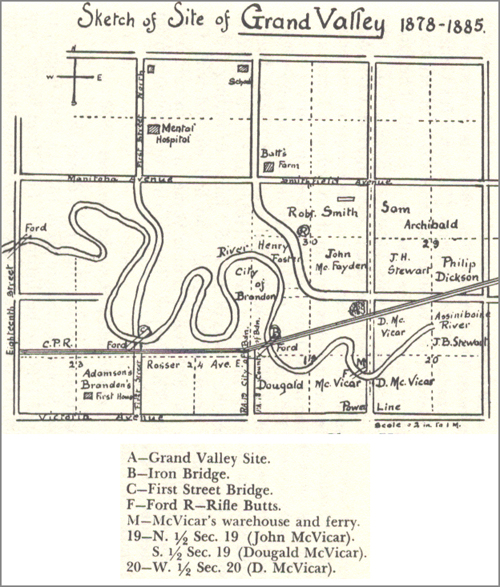
Grand Valley Map
- Kavanaugh, The Assiniboine Valley
General
Rosser
Enter Thomas
Lafayette Rosser, Chief Engineer of the CPR. Rosser was not your
typical railroad engineer. In fact, it is proper to refer to him as
General Rosser, an American no less, southerner even, and a
well-respected veteran of the American Civil War.
In fact he was
also a friend of the late Union General, George Armstrong Custer, his
former adversary, with whom he had worked in his previous position with
the U.S. Northern Pacific Railway. Custer’s ill-fated 7th Cavalry had
been assigned to protect the workers and he and Rosser had struck up a
friendship.
Now Rosser was
about to play a pivotal role in the settlement patterns of the Canadian
West.
In the spring of
1881 he crossed the Assiniboine River at a point about 200 kilometres
west of Winnipeg, bargained briefly with a Mr. Adamson and purchased
the town site of Brandon for little more than a song.
As with many
other deals struck in the creation of railway towns in the era,
potential profit for Mr. Rosser was a consideration. He’d just rejected
the site of Grand Valley, just a few kilometres downriver in a famous
confrontation with area pioneer John McVicar, who had his own notions
about profit.
James Secretan, a
CPR surveyor who worked with Rosser reported that Rosser indeed made a
$25000 offer for the Grand Valley site, and when McVicar countered with
a request for $50000, the General abruptly ended negotiations and moved
on upstream.
According to
Brandon pioneer Beecham Trotter’s account, the negotiations ended with
Rosser saying, “I’ll be damned if a town of any kind is ever built
here.” (1)
And it wasn’t.
On May 13, the
Winnipeg Times reports that, "Gen. Rosser is laying out the station
grounds and Mr. Vaughn is surveying the town plot adjoining the station
at Grand Valley, the Canadian Pacific Railway crossing of the
Assiniboine."
A few days later
(May 16) they report that the station will be on section 23, township
10, range 19, (the site of present day Brandon).
The name Brandon
has not yet been used, and on the very next day large ads appear under
headings such as, "The Grand Valley Crossing, site of the Great City of
the C.P.R and crossing of the Assiniboine River", and announcing that
said town" has been located by the Chief Engineer of the C.P.R. on
Section 23, Township 10, Range 19 West, On the south-west side of the
river". The ad continues in this vein making it clear that the C.P.R.
station will be on the aforementioned site and that .."Any other lots
advertised are from two to three miles distant from the station."
(Winnipeg Times, May 17, 1881)
This was a direct
response to the continued efforts to promote the original Grand Valley
location. But the issue was settled. The battle fought and won. Brandon
had a railway station and it would be the C.P.R. town. The
arrival of the CPR in the spring of 1881, transformed an empty stretch
of riverbank into a bustling city, almost overnight.
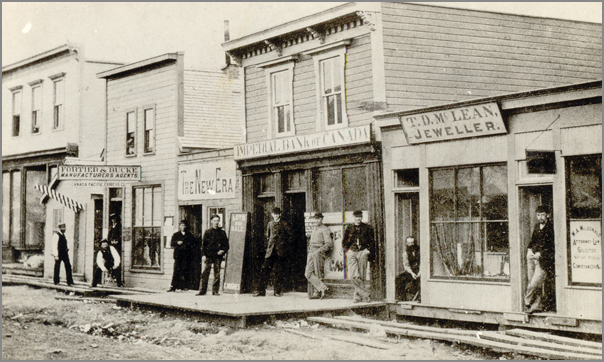
RosserAve1881
(Archives of Manitoba)

Sixth
Street
1883 (Archives of Manitoba)
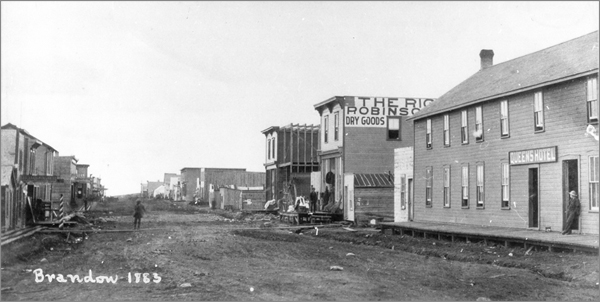
In 1883
from
corner of Sixth and Rosser, looking north towards Pacific Avenue and
the Assiniboine River the three-storey Grand Central Hotel dominated
the streetscape.
By 1883 it had
progressed from a tent town of a few hundred souls and assorted
makeshift businesses to crowded streets lined with well-built stores
and hotel.
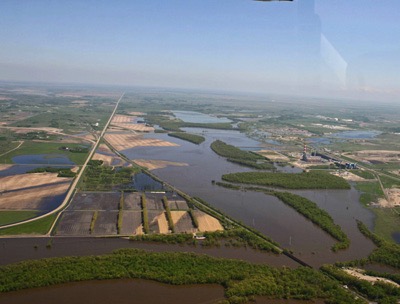 The
Grand Valley
site May, 2011. The village was near the centre of this photo - under
water as it was in June of 1881. Regardless of the details - the right
decision was made.
The
Grand Valley
site May, 2011. The village was near the centre of this photo - under
water as it was in June of 1881. Regardless of the details - the right
decision was made.
|



